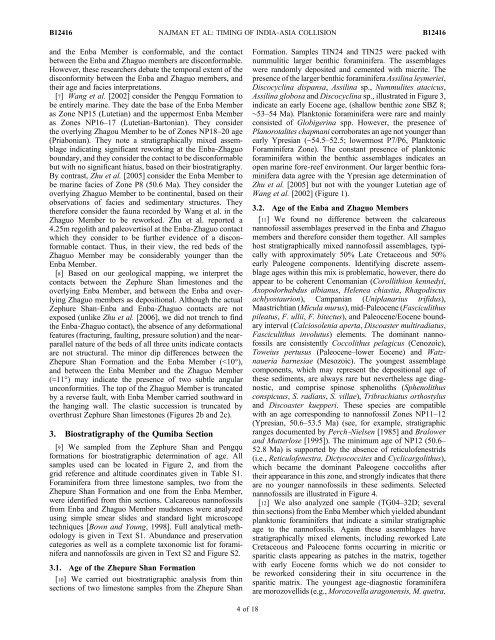Timing of IndiaâAsia collision: Geological, biostratigraphic, and ...
Timing of IndiaâAsia collision: Geological, biostratigraphic, and ...
Timing of IndiaâAsia collision: Geological, biostratigraphic, and ...
You also want an ePaper? Increase the reach of your titles
YUMPU automatically turns print PDFs into web optimized ePapers that Google loves.
B12416<br />
NAJMAN ET AL: TIMING OF INDIA‐ASIA COLLISION<br />
B12416<br />
<strong>and</strong> the Enba Member is conformable, <strong>and</strong> the contact<br />
between the Enba <strong>and</strong> Zhaguo members are disconformable.<br />
However, these researchers debate the temporal extent <strong>of</strong> the<br />
disconformity between the Enba <strong>and</strong> Zhaguo members, <strong>and</strong><br />
their age <strong>and</strong> facies interpretations.<br />
[7] Wang et al. [2002] consider the Pengqu Formation to<br />
be entirely marine. They date the base <strong>of</strong> the Enba Member<br />
as Zone NP15 (Lutetian) <strong>and</strong> the uppermost Enba Member<br />
as Zones NP16–17 (Lutetian‐Bartonian). They consider<br />
the overlying Zhagou Member to be <strong>of</strong> Zones NP18–20 age<br />
(Priabonian). They note a stratigraphically mixed assemblage<br />
indicating significant reworking at the Enba‐Zhaguo<br />
boundary, <strong>and</strong> they consider the contact to be disconformable<br />
but with no significant hiatus, based on their biostratigraphy.<br />
By contrast, Zhu et al. [2005] consider the Enba Member to<br />
be marine facies <strong>of</strong> Zone P8 (50.6 Ma). They consider the<br />
overlying Zhaguo Member to be continental, based on their<br />
observations <strong>of</strong> facies <strong>and</strong> sedimentary structures. They<br />
therefore consider the fauna recorded by Wang et al. in the<br />
Zhaguo Member to be reworked. Zhu et al. reported a<br />
4.25m regolith <strong>and</strong> paleovertisol at the Enba‐Zhaguo contact<br />
which they consider to be further evidence <strong>of</strong> a disconformable<br />
contact. Thus, in their view, the red beds <strong>of</strong> the<br />
Zhaguo Member may be considerably younger than the<br />
Enba Member.<br />
[8] Based on our geological mapping, we interpret the<br />
contacts between the Zephure Shan limestones <strong>and</strong> the<br />
overlying Enba Member, <strong>and</strong> between the Enba <strong>and</strong> overlying<br />
Zhaguo members as depositional. Although the actual<br />
Zephure Shan‐Enba <strong>and</strong> Enba‐Zhaguo contacts are not<br />
exposed (unlike Zhu et al. [2006], we did not trench to find<br />
the Enba‐Zhaguo contact), the absence <strong>of</strong> any deformational<br />
features (fracturing, faulting, pressure solution) <strong>and</strong> the nearparallel<br />
nature <strong>of</strong> the beds <strong>of</strong> all three units indicate contacts<br />
are not structural. The minor dip differences between the<br />
Zhepure Shan Formation <strong>and</strong> the Enba Member (

















